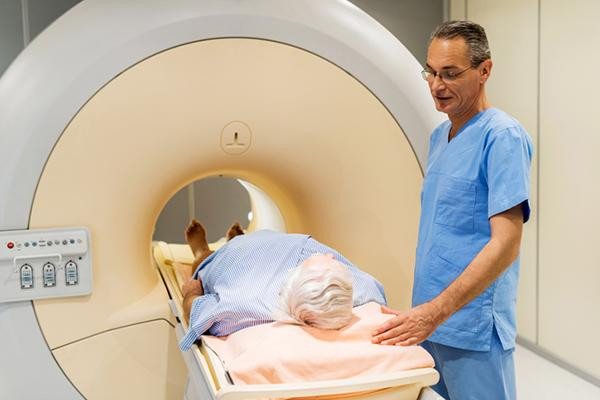
Could imaging scans replace biopsies during prostate cancer screening?

Abnormal results on a prostate-specific antigen (PSA) screening test for cancer are typically followed by a systematic biopsy. During that procedure, doctors use a long needle to extract roughly a dozen samples from the prostate while looking at the gland on an ultrasound machine. Those samples can then be checked for cancer under a microscope.
Limitations and concerns
But systematic biopsies can be problematic. A major concern is that they overdiagnose low-grade, slow-growing tumors that might never become life-threatening, thereby leading to unnecessary treatments.
Researchers are seeking alternatives to the systematic biopsy in men flagged by PSA screening. One option is to start with a magnetic resonance imaging (MRI) scan of the prostate, and then focus the biopsy only on areas that look suspicious for cancer. This is called an MRI-targeted biopsy, and it’s becoming increasingly common.
Could an MRI miss early-stage cancer that later turns out to be incurable? This is an outstanding worry, especially since systematic biopsies sometimes find newly-forming cancer that MRIs aren’t yet able to detect. Indeed, systematic and targeted biopsies are often given together to boost the odds of finding clinically significant disease that may need immediate treatment.
Methodology
Now, a large Swedish study provides encouraging evidence favoring the MRI-only approach.
The team invited 38,316 men ranging from 50 to 60 years in age to undergo PSA screening. If a man’s PSA level was 3.0 nanograms per milliliter (ng/mL) or higher, then he was enrolled into the study. The investigators wound up with 13,153 men who were randomly distributed between two groups:
- Systematic biopsy group: All the men in this group got a systematic biopsy plus an MRI. If a man’s MRI was positive for suspicious lesions, then he also got a targeted biopsy.
- MRI-targeted biopsy group: All of the men in this group got an MRI, but none got a systematic biopsy. Men with suspicious lesions on MRI got a targeted biopsy.
This initial screening round was followed by repeat screening rounds — all following the same protocols — at two-, four-, and eight-year-intervals.
What the study showed
After a median follow-up of 3.9 years (starting from and including the first screening round), prostate cancer had been detected in 185 men from the MRI-targeted group and 298 men from the systematic biopsy group. Systematic biopsies generated more clinically insignificant cancer diagnoses — 159 compared to 68 in the MRI-targeted group. During the first screening round, “The risk of such a diagnosis was 51% lower in the MRI-targeted biopsy group than the systematic biopsy group,” the authors wrote.
The authors emphasized that omitting biopsies in patients with MRI-negative results cut diagnoses of clinically insignificant cancer, meaning cancer that is slow-growing and may never need treatment, by more than half. “And importantly, the associated risk of detecting clinically significant cancer during follow-up and at later screening visits was very low in both groups,” said Dr. Jonas Hugosson, chief urologist at the University of Gothenberg and the study’s first author. “A total of 14 such cases (0.2 % of men who participated) were diagnosed in the systematic biopsy group and eight (0.1 %) in the MRI-targeted biopsy group.”
Commentary from experts
“This study provides encouraging — though very early — data that supports the increasing use of MRI as the first diagnostic modality, following evaluation of an abnormal PSA value,” said Dr. Marc Garnick, the Gorman Brothers Professor of Medicine at Harvard Medical School and Beth Israel Deaconess Medical Center, and editor-in-chief of the Harvard Medical School Guide to Prostate Diseases. “The practice of not automatically going to prostate needle biopsy when an abnormal PSA is detected has gained in popularity in Europe, and this study may help increase its usefulness in the United States.”
“While these results are encouraging, the decision to omit biopsy in men with a negative MRI must be individualized based on the risk of detecting prostate cancer,” added Dr. Boris Gershman, a urologist at Beth Israel Deaconess Medical Center and an assistant professor at Harvard Medical School focusing on prostate and bladder cancer. “For example, biopsy may still be considered in men with markedly elevated PSA, even if the prostate MRI does not identify any lesions.”
About the Author

Charlie Schmidt, Editor, Harvard Medical School Annual Report on Prostate Diseases
Charlie Schmidt is an award-winning freelance science writer based in Portland, Maine. In addition to writing for Harvard Health Publishing, Charlie has written for Science magazine, the Journal of the National Cancer Institute, Environmental Health Perspectives, … See Full Bio View all posts by Charlie Schmidt
About the Reviewer

Marc B. Garnick, MD, Editor in Chief, Harvard Medical School Annual Report on Prostate Diseases; Editorial Advisory Board Member, Harvard Health Publishing
Dr. Marc B. Garnick is an internationally renowned expert in medical oncology and urologic cancer. A clinical professor of medicine at Harvard Medical School, he also maintains an active clinical practice at Beth Israel Deaconess Medical … See Full Bio View all posts by Marc B. Garnick, MD


